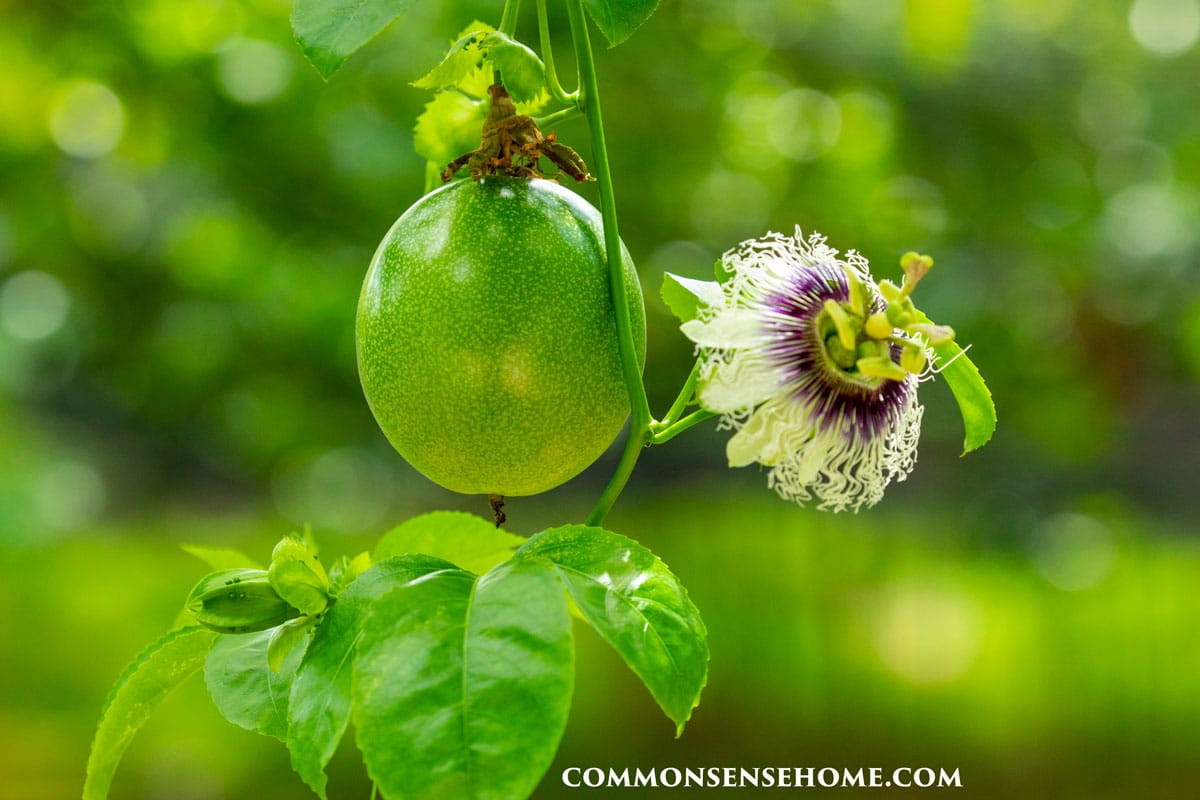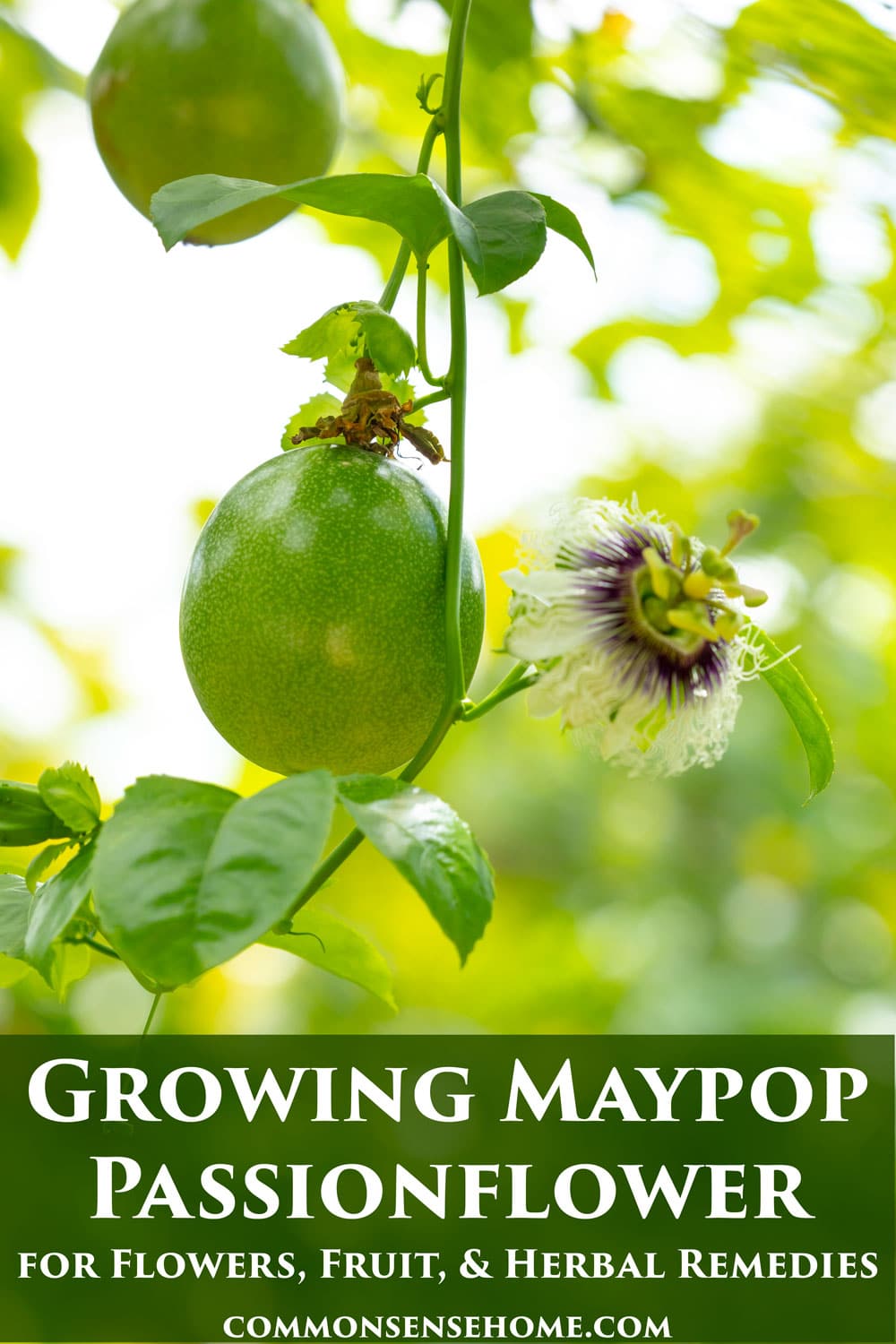Growing Passionflower for Flowers, Fruit, & Herbal Remedies
This post may contain affiliate links. Read my full disclosure here.
Passion flower (Passiflora incarnata) is native to the southeastern United States. This fast growing vine produces edible fruits, dark green leaves, and fragrant flowers. We share tips for growing passionflower as a beautiful addition to your home garden.

Introduction
The Passiflora genus includes over 500 species, among them the weedy, climbing vine known as Passionflower. Passionflower species grow in South America, and certain regions of the United States including Delaware, Missouri, Texas, and Florida.
The distinctive flowers of Passionflower bloom from midsummer to early fall, but have a brief lifespan of just one day.
In USDA zones 7-11, passionflower is cultivated as a perennial. In cooler climates, passion flower vines dies back during the winter months. Some varieties are hardy to USDA zone 5.
The tropical species (Passiflora edulis) produces the delicious passion fruit. Southeast native Passiflora incarnata produces smaller fruit known as maypops.
The name “passionflower” comes from the plant’s association with the Christian story of the Passion of Christ. Early Spanish explorers thought its flowers resembled different parts of the crucifixion story.
Passion flowers attract many pollinators, including wasps, bees, and butterflies such as the Gulf Fritillary and Variegated Fritillary.
Growing Passionflower from Seed
To grow passionflower from seed, first make sure that you have the correct variety. The Passiflora genus has plants with different medicinal uses, and not all the fruit is edible.
P. incarnata (maypop) is most widely used for medicine. Purple passionflower (P. edulis) is also medicinal, but with different properties. P. edulis produces passionfruit, and is native to South America.
Preparing Your Seeds
Passionflower is fairly easy to grow, but the seeds need to be “scarified” to initiate the germination process.
To scarify, you can rub the seeds between two pieces of sandpaper to expose the endosperm. You can also use a paring knife to make a small cut in the seed, or even snip an end with fingernail clippers. Then soak the seeds in warm water for a couple days. Seeds that float are not viable.
Starting Seeds Indoors
To start seeds indoors, fill your trays or peat pots with a peat-based potting mix, or soil starter pellets. Plant passion flower seeds at a depth of 8mm, and maintain a warm and consistently moist environment.
Expect germination to take place within approximately 21-84 days. Once sprouts emerge, it’s best to shield them from direct light until the second set of leaves appear. Seeds may germinate at different rates, so don’t toss any until you are ready to transplant in the spring.
Transplanting
In early spring, transplant the plants into pots with good drainage. Gradually introduce the plant to the outdoors, extending the duration of sunlight exposure each day. Harden off the plant over the course of 10 days to two weeks. This “hardening off” period eases the transition to outdoor conditions.
You can keep the plant in the pot to make it easier to bring inside for winter, or transplant into the soil after hardening.
Growing Passionflower in the Garden
Plant passionflower in the spring after the last frost has passed. Space the plants at least 3 to 5 feet apart. Choose a location with full sun and average soil. The leaves and flowers are somewhat delicate, so the plants benefit from wind protection.
The plants can be aggressive growers, so make sure you have access to prune them and mow around them. They also need a sturdy fence or trellis for support.
Dig a hole slightly larger than the root ball and place the plant in the hole at the same depth it was in the nursery container. Backfill with soil and water thoroughly.
Watering
Passionflower plants like consistent moisture, especially during the growing season. Water the plant regularly but allow the soil to dry out between watering to prevent waterlogged conditions.
Once established, passionflowers are somewhat drought-tolerant.
Fertilization
Passionflowers generally do not require heavy fertilization. Too much nitrogen can result in excessive vegetative growth at the expense of flowering. You can apply a balanced, all-purpose fertilizer in spring and early summer.
Support and Trellising
Passionflowers are vigorous climbers that benefit from support structures like trellises, fences, or arbors. Providing support helps them climb and enhances the ornamental appeal of the plant.
Would you like to save this?
Make sure the support structure is sturdy, as passionflower vines can become quite heavy. Vines may grow 15 to 25 feet per year, depending on conditions and species.
Pruning
Prune passionflower plants growing in the garden in late winter or early spring before new growth begins. This helps control the size of the plant and encourages a more compact, bushy growth habit. Remove any dead or damaged growth and prune to shape the plant.
Harvesting
Harvest Passiflora incarnata flowers, buds, and leaves for herbal remedies as flowering begins. See “Passionflower Benefits and Use Tips” for more information.
Harvest the fruits when they are fully ripe, usually in late summer or fall. For best flavor, wait until the skin starts to yellow, and fruits slip easily from the vine. The sweet pulp surrounds the seeds, like pomegranates.
Overwintering
During the winter, you can bring your plants indoors as houseplants until the next spring. When moving a passionflower plant inside for winter, cut the stems to 1 or 2 feet. This helps control its size and promotes better growth when it goes back outside. This pruning helps manage the plant’s size and encourages healthier regrowth when it transitions back outside.
Although the plant may enter a semi-dormant state and appear less vibrant, it should recover and rejuvenate come spring. For plants left in the garden, mulch around the base of the plant to protect the roots.
Common Pests and Diseases
Bugs like scale, spider mites, and whiteflies can harm passionflower plants in hot and humid climates. To address infestations, consider using a food-grade insecticide.
Another potential concern is leaf spot, often caused by fungal diseases. To manage this, remove affected leaves to curb the spread and, if necessary, treat the plant with a fungicide. In soils with poor drainage, root rot is a common issue, so ensure proper drainage.
Propagation via Cuttings
For cuttings take passion flower stems measuring approximately 6 centimeters in length. Choose stems that are soft at the tip but have hardened at the base. Remove the lower leaves, tendrils, and any new growth.
Plant the cutting in a pot filled with a peat based potting soil, keep warm and moist; they will root fairly quickly. Transplant to pots or to a garden space by a wall or trellis in moist, well draining soil in full sun.
Propagation via Layering
To grow passionflower by layering, remove leaves from a small section of the vine. Bend the plant over, and bury it partially in the soil. Secure it in place by using a small stone as an anchor.
Roots will start to develop within a month. Ensure that the anchor remains in place to help the plant become well-established and avoid being uprooted. Once it has roots, clip the new vine to separate it from the parent plant and move it to a new location.
More Growing Guides
It’s so satisfying to be able to grow your own food and medicine. We have a wide variety of growing guides on the website, including:
How to Grow Mint Plants (with Tips for Starting Cuttings)
Borage – Growing Tips and Uses
Black Chokeberry – Aronia melanocarpa – Growing and Use
Currants – Growing, Harvesting, and Uses
Autumn Olive – Uses, Control, Recipes

This article was written by Sylvia Gunther.
Sylvia studied under Rosemary Gladstar and earned the distinction of Traditional Herbalist. She then studied Clinical Herbalism through The Herbal Academy, where she continues her life long exploration of herbs.
Sylvia and her husband live in North Central Indiana. Together they raised six beautiful children.


